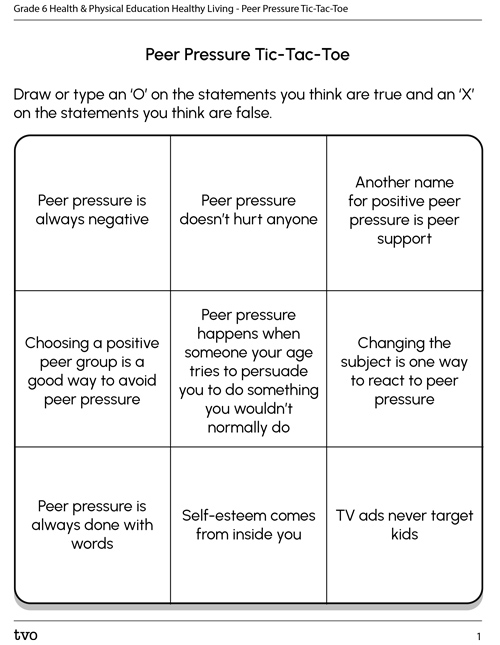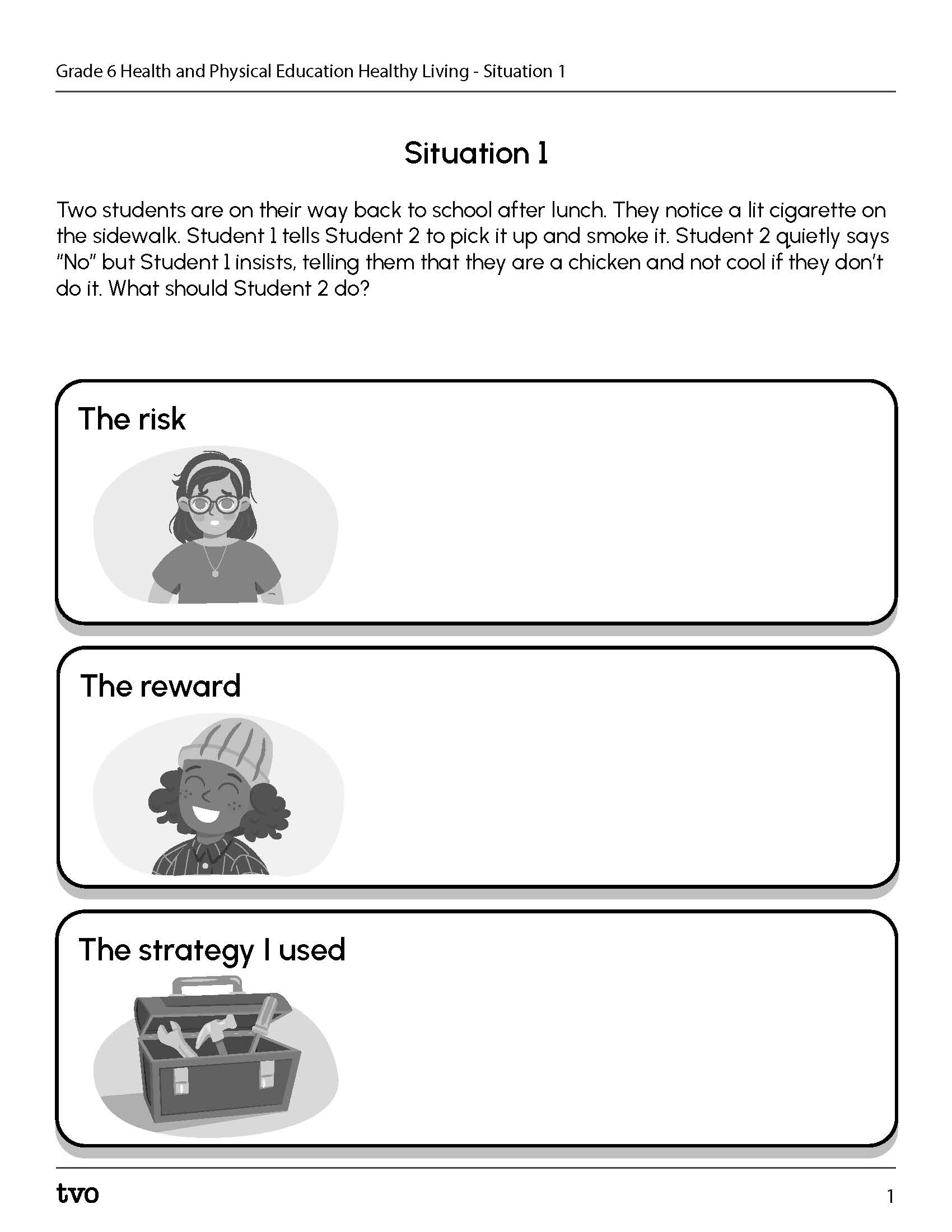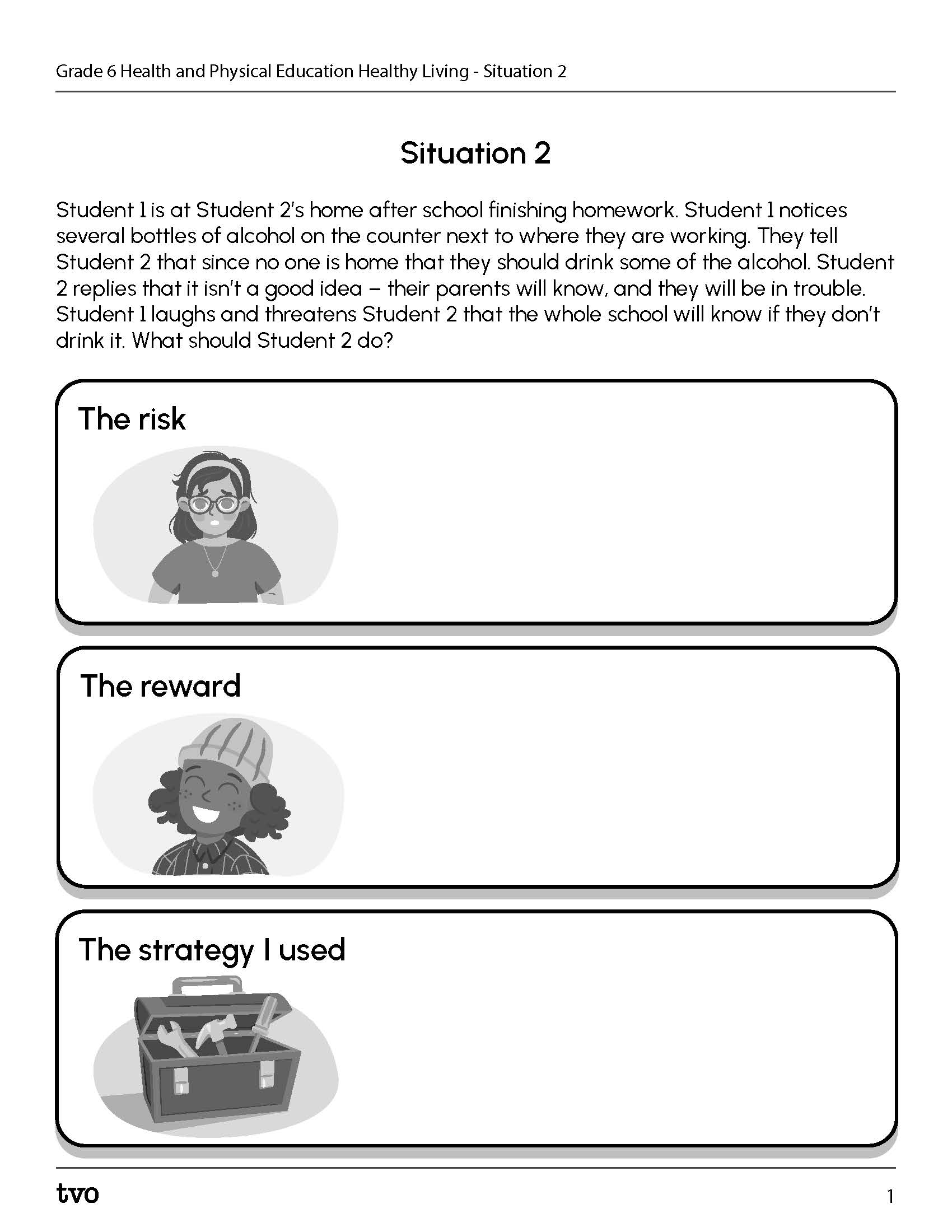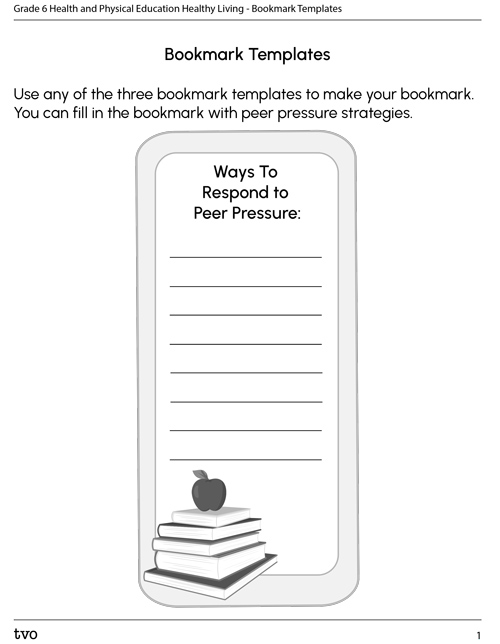Minds On
Tic-tac-toe

What do you already understand about peer pressure?
Let’s show what we know with tic-tac-toe!
Access the following fillable and printable Peer Pressure Tic-Tac-Toe. Your goal is to read each statement on the ‘board’ and decide if it’s true or false. If the statement is true, draw or type an ‘O’ in the box. If the statement is false, draw or type an ‘X’ in the box. Can you get a complete row?
You can also complete this activity in your notebook or using another method of your choice.
When you’re ready, press the ‘Answers’ button to reveal the answers to the tic-tac-toe activity.

Answers to the Peer Pressure Tic-Tac-Toe activity. The first box in the first row says "Peer pressure is always negative" and there is an X under the text. The second box in the first row says "Peer pressure doesn't hurt anybody" and there is an X under the text. The last box in the first row says "Another name for positive peer pressure is peer support" and there is an O under the text. The first box in the middle row says "Choosing a positive peer group is a good way to avoid peer pressure" and there is an O under the text. The second box in the middle row says "Peer pressure happens when someone your age tries to persuade you to do something you wouldn't normally do" and there is an O under the text. The last box in the middle row says "Changing the subject is one way to react to peer pressure" and there is an O under the text. The first box of the last row says "Peer pressure is always done with words" and there is an X under the text. The second box in the last row says "Self-esteem comes from inside you" and there is an O under the text. The last box in the last row says "TV ads never target kids" and there is an X under the text.
Pause and Reflect
Pause and reflect
Based on the tic-tac-toe activity, what areas of peer pressure do you feel that you need more information about? Did any of the information surprise you?
Record your thinking digitally, orally, or in print.
Action
Facts first

Substances such as cannabis, alcohol, tobacco, and vape products can affect both your mental and physical health. They can impact your relationships to others as well.
You may encounter peer pressure from people encouraging you to experiment with these substances. Having the facts about the potential effects will make it easier to resist them.
Explore the following facts about these substances. You will have an opportunity to reflect on your learning about each substance.
Cannabis

Can affect your performance at school
- contributes to behaviours like withdrawing from family and friends
- may have an impact on motivation to do things
- causes problems with the law, because it is illegal to use, buy, possess, cultivate, or share recreational cannabis if you are underage
- can be used for some medical purposes, such as relieving nausea and stimulating appetite in patients who are living with cancer, AIDS, or other medical conditions
Pause and Reflect
Pause and reflect
Consider the life of a Grade 6 student right now. How could cannabis affect their daily activities? How could it affect the rest of their life?
Record your thinking using a method of your choice.
Alcohol

Can cause health and social consequences because it is intoxicating and causes dependence
- blocks some of the messages trying to get to the brain which alters a person’s perceptions, emotions, movement, vision, and hearing
- causes confusion and disorientation
- can make someone very friendly and talkative or aggressive and angry
- can cause problems with school as it damages a student’s ability to focus, study, retain information, and affect sports performance
Pause and Reflect
Pause and reflect
Explain how alcohol could affect the current life of a Grade 6 student. How could it affect their plans for the future?
Record your thinking using a method of your choice.
Tobacco and vaping

Causes significant health problems including respiratory illnesses like bronchitis, COPD, persistent coughing, and lung cancer
- can dull the sense of smell and taste which causes loss of appetite
- affects vision and can lead to glaucoma, macular degeneration, and cataracts
- may cause blood clots, wrinkly skin, yellow fingers, high cholesterol, smelly hair, and stained teeth
- affects personalities through mood change, anxiety, and irritability
- nicotine and vaping affect the development of the part of the brain that’s responsible for decision making and impulse control
- aerosol from e-cigarettes can contain harmful chemicals, including nicotine
- e-cigarettes contain ultrafine particles that are inhaled into the lungs (like flavouring such as diacetyl, benzene, which is found in car exhaust, and heavy metals, such as nickel, tin, and lead). These particles cause lung disease
Pause and Reflect
Pause and reflect
If a student used tobacco, how could it affect their life in Grade 6? How could it affect their plans for the future? Is vaping a positive or negative substitute for tobacco use? Explain.
Record your thinking using a method of your choice.
Show what you know!

Peer pressure is the feeling created by someone your own age pushing you toward making choices you wouldn’t normally make, good or bad. It can be both spoken and unspoken, and can lead to risky, dangerous, or personally unwanted behaviour.
Task #1: Strategy tool kit
Brainstorm a list of things that you could do to resist peer pressure. You can use this like a strategy tool kit! Since peer pressure can be positive and negative, be sure to include some positive statements of encouragement.
Create your checklist using the following fillable and printable Peer Pressure Strategy Tool Kit. There are three examples to get you started.
You can also complete your checklist using another method of your choice.
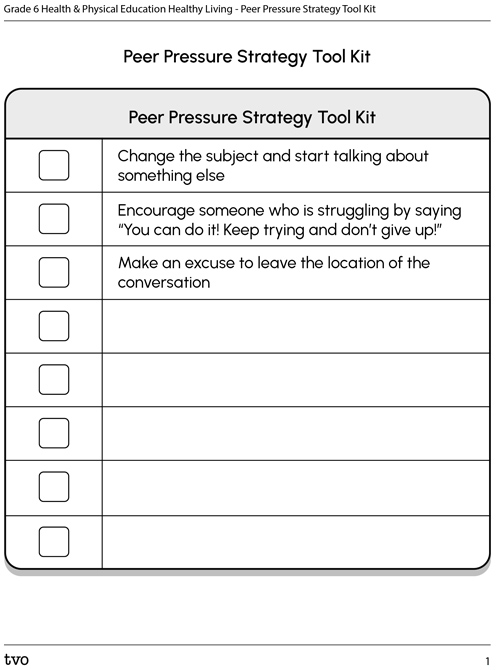
Press the Activity button to access Peer Pressure Strategy Tool Kit.
Activity (Open PDF in a new tab)After you have finished your checklist, you can press the ‘Answers’ button to reveal some possible peer pressure strategies.
- Change the subject and start talking about something else.
- Encourage someone who is struggling by saying, “You can do it! Keep trying and don’t give up!”
- Make an excuse to leave the location of the conversation.
- Say, “No!”
- Walk away.
- Use humour.
- Ignore the person.
- Find an ally to help you say no.
- Say, “No thanks, I don’t do drugs.”
- Encourage someone by saying, “You’re amazing. Don’t talk yourself out of it.”
Task #2: Peer pressure situations
In this activity, you will read through three scenarios and apply one of the strategies from your Strategy Tool Kit to help resolve the peer pressure situations.
Be sure to include the RISK if the student gives in the peer pressure and the REWARD if they don’t. Explore the following tabs to learn more.
Here are the three situations. Read through each situation and then record your ideas.
Situation 1

Two students are on their way back to school after lunch. They notice a lit cigarette on the sidewalk. Student 1 tells Student 2 to pick it up and smoke it. Student 2 quietly says “No” but Student 1 insists, telling them that they are a chicken and not cool if they don’t do it. What should Student 2 do?
What peer pressure strategy would you use to resolve this situation? What are the risks? What are the rewards?
Record your ideas in the following fillable and printable Situation 1 document. You can also use another method of your choice.
Situation 2

Student 1 is at Student 2’s home after school finishing homework. Student 1 notices several bottles of alcohol on the counter next to where they are working. They tell Student 2 that since no one is home that they should drink some of the alcohol. Student 2 replies that it isn’t a good idea – their parents will know, and they will be in trouble. Student 1 laughs and threatens Student 2 that the whole school will know if they don’t drink it. What should Student 2 do?
What peer pressure strategy would you use to resolve this situation? What are the risks? What are the rewards?
Record your ideas in the following fillable and printable Situation 2 document. You can also use another method of your choice.
Situation 3

Student 1 and Student 2 are both trying out for the Art Club. While making their masterpieces, Student 1 throws down their pencil in frustration. “I am never going to make it into Art Club. I’m not an artist!” Student 2 puts down their pencil and replies, “Your drawings are displayed in the classroom – they are amazing!” What should Student 2 do?
What peer pressure strategy would you use to resolve this situation? What are the risks? What are the rewards?
Record your ideas in the following fillable and printable Situation 3 document. You can also use another method of your choice.
Pause and Reflect
Pause and reflect
What might be a reason that people give in to peer pressure? What feelings can result from being pressured?
Record your ideas in a method of your choice.
Consolidation
Knowledge exchange!

Using the expertise gained from the Action section activities, design and create a bookmark to share positive ways to respond to peer pressure. Your bookmark should list some of the strategies we discussed.
You can use the following fillable and printable Bookmark Templates document to complete your bookmark. You can also draw your bookmark on paper or using another method of your choice.
Reflection
As you read through these descriptions, which sentence best describes how you are feeling about your understanding of this learning activity? Press the button that is beside this sentence.
I feel…
Now, record your ideas using a voice recorder, speech-to-text, or writing tool.
Press ‘Discover More’ to extend your skills.
Discover MoreA different perspective
Let’s consider a different perspective on peer pressure.
- How does peer pressure change as you get older?
- Explain how the peer pressure someone may have experienced in Grade 1 compares to the peer pressure someone might feel in Grade 6.
- What do you think peer pressure might be like in high school?
Record your thinking using a method of your choice.
